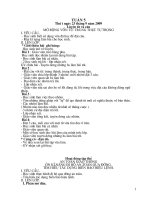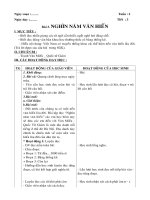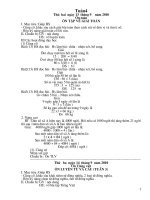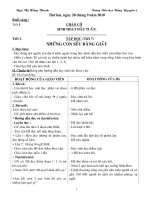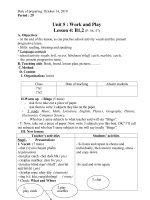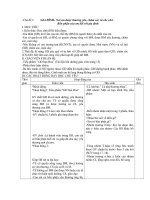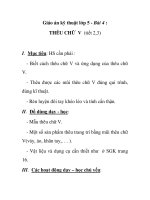- Trang chủ >>
- Mầm non - Tiểu học >>
- Lớp 5
5 2 4 endangered animals TG
Bạn đang xem bản rút gọn của tài liệu. Xem và tải ngay bản đầy đủ của tài liệu tại đây (114.81 KB, 4 trang )
5.2.4
Endangered Animals
SUMMARY
Though animal extinction is a part
of nature, human actions can cause animals
to become extinct faster than they naturally
would. The author explains how this happens
and what people have done to prevent giant
pandas, manatees, and other endangered
animals from suffering this fate.
LESSON VOCABULARY
conservation
enthusiastic
investigation
contribute
environment
INTRODUCE THE BOOK
INTRODUCE THE TITLE AND AUTHOR
Discuss
with students the title and the author of
Endangered Animals. Invite them to ask
questions about the title. What does it
mean to be endangered? What animals are
endangered? Point out that the cover image
may offer clues on how the author will answer
some of these questions.
BUILD BACKGROUND
Ask students to think
about the roles that animals play in their
everyday lives. Discuss what would happen if
these animals disappeared forever. How would
people’s food, clothing, and other aspects of
daily life change?
PREVIEW/USE TEXT FEATURES
Ask students
to flip through the book, glancing only at
the photos. Then have them preview it
again, taking time to study the images and
accompanying captions slowly and carefully.
Discuss how this second read-through
changes their understanding of the book’s
subject.
44
FACT AND OPINION
ASK QUESTIONS
READ THE BOOK
SET PURPOSE
Have students set a purpose
for reading Endangered Animals. This purpose
should be guided by their own interest
and questions about animals in danger
of extinction.
STRATEGY SUPPORT: ASK QUESTIONS
Good
questions often start with a question word,
such as who, what, when, where, why, and
how. They also ask about an important detail
of the story and can be answered in the
reading. Based on these criteria, ask students
to record questions they have while reading
about endangered animals. Afterward, have
volunteers share their questions as well as
the answers they found in the book.
COMPREHENSION QUESTIONS
PAGE 5
What are endangered species?
(animals that are in danger of becoming extinct)
PAGE 6
What U.S. law protects endangered
species? (the Endangered Species Act)
PAGES 8–11
What is the main reason why the
giant panda, spotted owl, and Karner blue
butterfly are all endangered or threatened?
(widespread loss of their natural habitats)
PAGE 16 Is the author stating a fact or opinion when she writes that “Peregrine falcons
became endangered because of a chemical
in the environment”? (She is stating a fact
because it can be proven true through scientific
evidence and observation.)
Endangered Animals
16911_LRD_TG_044-045 44
12/28/05 1:08:52 PM
REVISIT THE BOOK
READER RESPONSE
1. It is the writer’s opinion that the insect is
beautiful. Where it once lived is fact.
2. Possible response: Which animals suffer
most from poaching? What are governments
doing to stop poaching? Is there anything
I can do?
3. Contribute can change to contribution.
Sample sentence: He made a strong contribution to the project.
4. Possible response: The map shows a huge
shrinkage of panda habitat over time.
EXTEND UNDERSTANDING
Tell students to look
at the map on page 8 and discuss what they
can learn from it. Point out how the map’s key
tells them this information and then provide
other examples of how map features such as
symbols, scales, and compass roses convey
data. Maps should indicate the location of
other habitats mentioned in the book.
Have students compare English terminology such as conservation, environment, and
investigation with related words in their home
language.
RESPONSE OPTIONS
WRITING
Invite students to create endangered
and threatened animal trading cards based
on what they have learned from the book
and from other reference materials. On blank
index cards they should write facts about
each animal, including details about its name,
habitat, food, reasons for being endangered
or threatened, and other information that
students find interesting.
SCIENCE CONNECTION
Students can learn more
about endangered animals
by using reference sources and
Web sites of zoos. Suggest that they
focus on how species become endangered
and what people are doing to help save them.
Skill Work
TEACH/REVIEW VOCABULARY
Invite students to make up sentences,
each of which includes and helps define a
vocabulary word from the glossary.
TARGET SKILL AND STRATEGY
FACT AND OPINION Explain that a
statement of fact can be proven true or
false by reading, observing, or asking an
expert. A statement of opinion is a judgment
or belief that cannot be proven true or false
but can be supported or explained. Help
students make distinctions between the
two types by creating a two-column chart on
the board, with one column titled Statement
of Fact and the other titled Statement of
Opinion. Read aloud statements from the
book. Challenge students to identify what
types of statements they are. Write each
statement in the appropriate column.
ASK QUESTIONS It is important to ask
good questions about text information.
Asking questions before, during, and after
reading helps students activate prior
knowledge, clarify confusion, engage with
text, and remember important ideas. By
asking the right questions, students can
determine whether or not an author is making
statements of fact or opinion.
ADDITIONAL SKILL INSTRUCTION
GENERALIZE Tell
students that a generalization
is a broad statement that applies to many
examples. Students can determine what
generalizations the author makes by thinking
about a number of specific animals in
the book and deciding what they have in
common. Students can then use their own
knowledge, as well as facts in the book,
to decide whether a generalization is valid.
Provide examples of generalizations from the
book, such as “Overfishing threatens many
species of fish” on page 14 and then invite
students to find their own.
Endangered Animals
16911_LRD_TG_044-045 45
45
12/28/05 1:08:54 PM
Endangered Animals
Name
Fact and Opinion
• A statement of fact can be proven true or false by reading, observing, or asking an expert.
• A statement of opinion is a judgment or belief. It cannot be proven true or false but can be
supported or explained.
Directions Read the following passage. Decide which sentences are facts and which sentences are
opinions. Then complete the chart below.
A law called the Endangered Species Act protects endangered and threatened species. It is
one of the most important laws in America. Under the Endangered Species Act, endangered
species of animals are listed by the government. Then plans are made to keep the species from
becoming extinct. The government must try to protect the animal habitats from being destroyed
and may breed young animals in captivity for release in the wild. Hunting and fishing for
endangered animals might be limited by the government.
Some people’s jobs or businesses are affected by these rules. But saving endangered species
is worth the sacrifice. Without protection, many animals will disappear from the Earth forever.
Statements of Opinion
© Pearson Education 5
Statements of Fact
46
16911_LRD_TG_046-047 46
12/28/05 1:09:28 PM
Endangered Animals
Name
Vocabulary
Directions Write the word from the box that best completes each sentence.
Check the Words You Know
conservation
environment
contribute
investigation
1. Our class will
enthusiastic
cupcakes to the school bake sale.
2. The police are conducting an
of the robbery.
3. A hot, dry desert is the perfect
for a camel.
4. I love animals, so I am
about my job at the pet store.
5. The
of habitats will help save endangered animals.
Directions Circle the word that has the same meaning as the vocabulary word.
6. contribute
neglect
harm
help
7. conservation
waste
guarding
destruction
8. enthusiastic
excited
disinterested
uncaring
9. environment
people
object
setting
examination
test
routine
10. investigation
Directions Write a sentence of your own for each vocabulary word.
11.
© Pearson Education 5
12.
13.
14.
15.
47
16911_LRD_TG_046-047 47
12/28/05 1:09:30 PM
